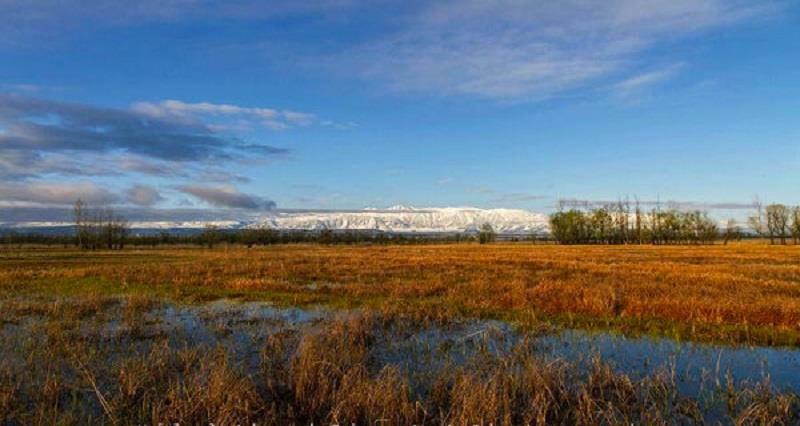
Experts Welcome Addition Of 2 More Kashmir Wetlands To Ramsar Sites
File photo of Shallabugh wetland
'Shallabugh, Haigam Wetlands Will Get A New Lease Of Life'
Srinagar- Shallabugh and Haigam wetlands in the Kashmir Valley are likely to get a new lease of life after being added to the list of Ramsar sites by the government of India, a move welcomed by the environmental experts for the preservation of the shrinking water bodies.
On August14, Union Environment Minister Bhupendra Yadav announced that India has added 11 more wetlands to the list of Ramsar sites, marshes that are of international importance, bringing the country's total tally to 75. Among the 11, the government listed two wetlands —Shallabugh and Haigam from Kashmir.
Shallabugh wetland in Ganderbal is spread over 1675 area hectares square kilometres while the Haigam wetland which is spread over 801.82 hectares is located in North Kashmir's Baramulla district.
Earlier, the government had added two water bodies—Wullar and Hokersar to the list of Ramsar sites.
Advocate Nadeem Qadri, environmental lawyer, told Kashmir Observer that Government of India is duty bound to protect, preserve and conserve these wetlands.
“It will definitely help the Government of Jammu and Kashmir to develop a comprehensive action plan for eco-restoration of both the wetlands,” Qadri said.
He further said that both the wetlands will receive the international focus and the national importance for its management purpose.
It may be noted both the water bodies were notified of protected wetlands with the department of wildlife protection. There are a total six protected wetlands in Jammu & Kashmir.
Qadri who is also the Executive Director, Wildlife Conservation Fund, Jammu & Kashmir argues that the addition will set the new trend for the conservation and management of these important wetland ecosystems.
“I think the announcement will ultimately strengthen the conservation of all these water bodies with special focus on Ramsar sites,” he adds.
The Ramsar Convention on Wetlands is an international treaty for“the conservation and sustainable use of wetlands”. It is named after the city of Ramsar in Iran where it was signed on 2nd of February 1971. Since then, February 2, every year is celebrated as World Wetlands Day. India is one of the contracting parties to the Ramsar Convention.
Dr. Arshad Jehangir, noted environmentalist, told Kashmir Observer that this was a much needed step to save the wetlands as the water bodies have witnessed rampant encroachment over the years.
“These wetlands will be demarcated and different types of activities like encroachment will not be allowed now,” he said.
While welcoming the step, Jehangir added that these wetlands have rich diversity of microfiber and host a number of birds during winter season.
Every year, thousands of migratory birds from different areas of the world arrive in Kashmir during winter when freezing temperatures in their summer habitats make food scarce.
The birds include teal, common pochard, merganser, northern shoveler, northern pintail, Eurasian wigeon, red-crested pochard, tufted duck, sheldrake duck, mallard, coot, gadwall, Brahminy duck, cormorant, Greylag goose.
They start arriving in October and stay until the end of April but their home—wetlands are being encroached rapidly.
According to reports, many migratory birds are now leaving earlier because of the shrinking of the wetlands.
Advocate Qadri, however, argues that the wetlands need a strong action plan for their preservation.
“I must says the Hokersar wetland, being listed in Ramsar sites is not in a good condition and needs urgent attention from the government,” Qadri added
He said there needs to be an action plan and strategy to conserve these wetlands and to enhance the bird diversity.
An official from the Wildlife Department told Kashmir Observer that the department manages wetlands through various activities like construction of bunds to regulate water level, de-silting and de-weeding, maintenance of water pools and water channels, anti-poaching/anti-grazing activities, awareness and publicity programmes, etc.
Rouf Zargar, the wildlife warden for South Kashmir, however told Kashmir Observer that the government has demarcated and protected all the notified wetlands in the valley and it is because of efforts of the department that two more wetlands have even listed in Ramsar sites.
“Why are millions of migratory birds from different parts of the world coming to these wetlands every year? Why don't they go to other water bodies? It is because of the good and natural habitations of notified wetlands that they take refuge in these wetlands,” Zargar told Kashmir Observer
Follow this link to join our WhatsApp group : Join Now

Legal Disclaimer:
MENAFN provides the
information “as is” without warranty of any kind. We do not accept
any responsibility or liability for the accuracy, content, images,
videos, licenses, completeness, legality, or reliability of the information
contained in this article. If you have any complaints or copyright
issues related to this article, kindly contact the provider above.


















Comments
No comment